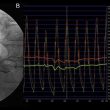Approximately 30% of patients undergoing percutaneous coronary intervention (PCI) present moderate to severe calcified lesions, which presents a significant challenge involving a high incidence of major adverse cardiovascular events (MACE). Rotational atherectomy (RA) is used to modify these calcified lesions and facilitate balloon angioplasty followed by stent implantation. The combination of RA with other plaque<a href="https://solaci.org/en/2023/11/30/rotacut-study-rotational-atherectomy-with-cutting-balloon-for-stent-expansion-optimization/" title="Read more" >...</a>
Stentless Strategy in ACS: Perfusion and Drug Coated Balloons
The initial strategy for the treatment of patients at high risk of bleeding (HBR) after percutaneous coronary intervention (PCI) has consisted of a short dual antiaggregation therapy (DAPT). Stents continue to improve, which has allowed the reduction of DAPT schemes and therefore the incidence of bleeding. However, researchers are also looking into another strategy to<a href="https://solaci.org/en/2023/11/22/stentless-strategy-in-acs-perfusion-and-drug-coated-balloons/" title="Read more" >...</a>
Long-Term Results from the BEST Study: Drug-Eluting Stents vs. Bypass Surgery in Diabetic Patients with Multiple Vessel Disease
The impact of diabetes on the development of cardiovascular disease is widely known, with a strong association with extensive and diffuse coronary artery disease. Decision-making regarding how to revascularize patients with multi-vessel disease is a complex process. In this context, coronary artery bypass grafting (CABG) has been recommended over percutaneous coronary intervention (PCI) based on<a href="https://solaci.org/en/2023/10/31/long-term-results-from-the-best-study-drug-eluting-stents-vs-bypass-surgery-in-diabetic-patients-with-multiple-vessel-disease/" title="Read more" >...</a>
TCT 2023 | In Stent Restenosis: Sirolimus vs. Paclitaxel Coated Balloons
This was a prospective, multicenter, randomized study including 130 patients with instent restenosis treated with sirolimus coated balloons (DCB S) and 128 treated with paclitaxel coated balloons (DCB P). Primary end point was late lumen loss (LLL) at 12 months. There were no significant differences between the groups. Mean patient age was 63, 75% were<a href="https://solaci.org/en/2023/10/30/tct-2023-in-stent-restenosis-sirolimus-vs-paclitaxel-coated-balloons/" title="Read more" >...</a>
Ultrathin Stents Shown Safe and Effective in Real World Patients
Ultrathin drug eluting stents (60 µm) had been shown beneficial vs. thin-strut stents in terms of target lesion failure (TLF) at 2, 3 and 5 years in randomized studies, but they had not been yet assessed in “real world” patients. The BIOFLOW VII is a prospective, multicenter study including 556 “real world”patients with a total<a href="https://solaci.org/en/2023/10/19/ultrathin-stents-shown-safe-and-effective-in-real-world-patients/" title="Read more" >...</a>
Treatment and Gender-Based Outcomes for Coronary Bifurcation Stent Placement: Report from the e-ULTIMASTER Registry
Approximately 20% of all percutaneous coronary interventions (PCI) are performed on bifurcation lesions, which continue to pose a challenge in terms of strategy: how many stents to use, what is the most suitable strategy, and when to transition from a single stent to two during the procedure. Additionally, the use of two stents in these<a href="https://solaci.org/en/2023/10/06/treatment-and-gender-based-outcomes-for-coronary-bifurcation-stent-placement-report-from-the-e-ultimaster-registry/" title="Read more" >...</a>
BIFURCAT Registry: 1 or 2 Stents? Treatment of Side Branch (Medina 0.0.1) Lesions According to Real-World Data
Coronary bifurcation lesions have been a subject to debate, with different approaches by various medical teams. These lesions often carry a higher risk of ischemic events compared with lesions at non-bifurcated sites. The main strategy, supported by medical society recommendations and clinical guidelines, involves using provisional stenting with one stent to minimize the number of<a href="https://solaci.org/en/2023/10/04/bifurcat-registry-1-or-2-stents-treatment-of-side-branch-medina-0-0-1-lesions-according-to-real-world-data/" title="Read more" >...</a>
Post PCI Functional Assessment for Focal Lesion and Stent Underexpansion Detection
The use of fractional flow reserve (FFR) and non-hyperemic pressure indices (NHPRs) have become essential for intermediate lesion revascularization. A linear inverse correlation has been recently shown between the use of post PCI physiology and cardiovascular events at followup. However, its adoption has been limited so far, seeing the wide variety of algorithms used in<a href="https://solaci.org/en/2023/06/29/post-pci-functional-assessment-for-focal-lesion-and-stent-underexpansion-detection/" title="Read more" >...</a>
Intrastent Restenosis in Ostial Lesions in the Right Coronary Artery: Predictors of an Unfavorable Location
Predictors of intrastent restenosis in the right coronary artery ostium. The ostium of the right coronary artery (RCA) presents certain histological aspects. Atherosclerotic and fibrotic plaques in this area contain an abundance of smooth muscle, collagen, and a certain degree of calcification, along with thicker adventitia. Additionally, it has certain anatomical aspects such as poor<a href="https://solaci.org/en/2023/06/16/intrastent-restenosis-in-ostial-lesions-in-the-right-coronary-artery-predictors-of-an-unfavorable-location/" title="Read more" >...</a>
Minimal Stent Area: New IVUS Parameter?
Intravascular Ultrasound (IVUS) has shown, in several studies, its great benefits for both restenosis and mortality reduction. Even though several variables have been studied, so far minimal stent area (MSA) has been disregarded as important. The OPTIVUS-Complex PCI looked at 961 patients with 1,957 lesions, and found 1.6% TLR incidence (30 lesions). There were no<a href="https://solaci.org/en/2023/06/14/minimal-stent-area-new-ivus-parameter/" title="Read more" >...</a>









